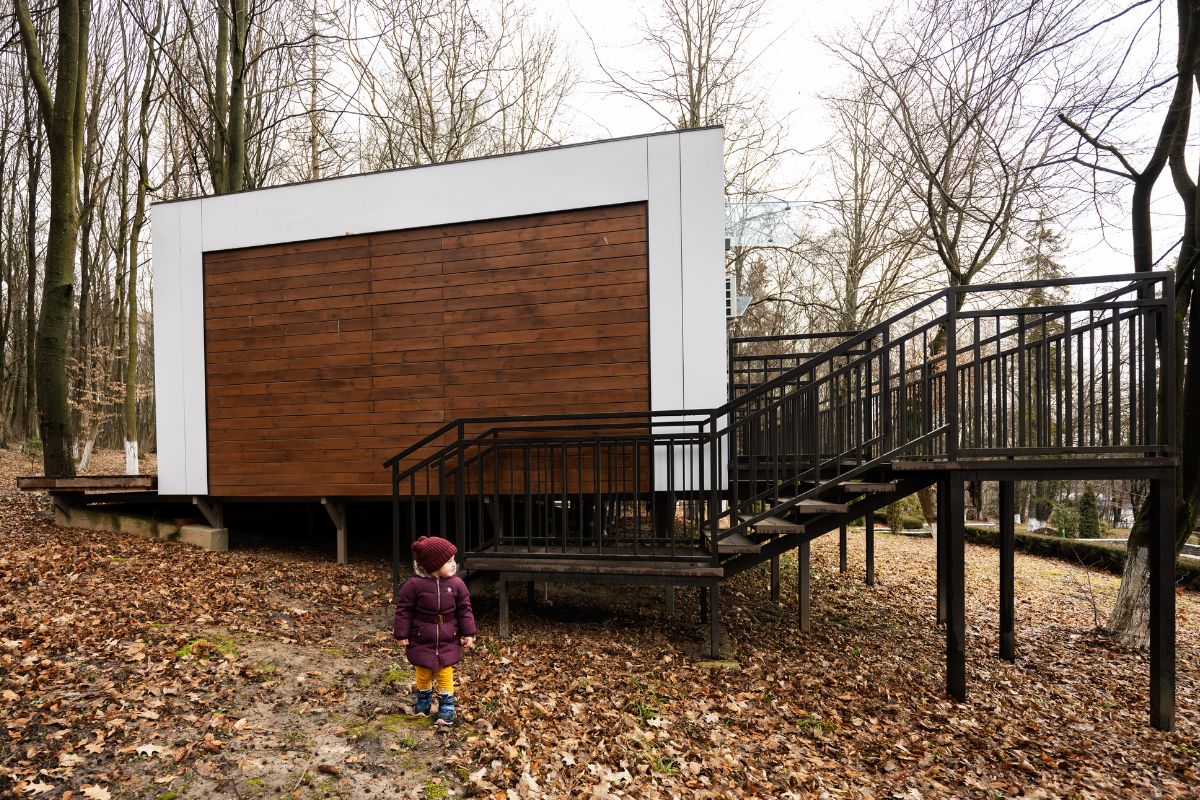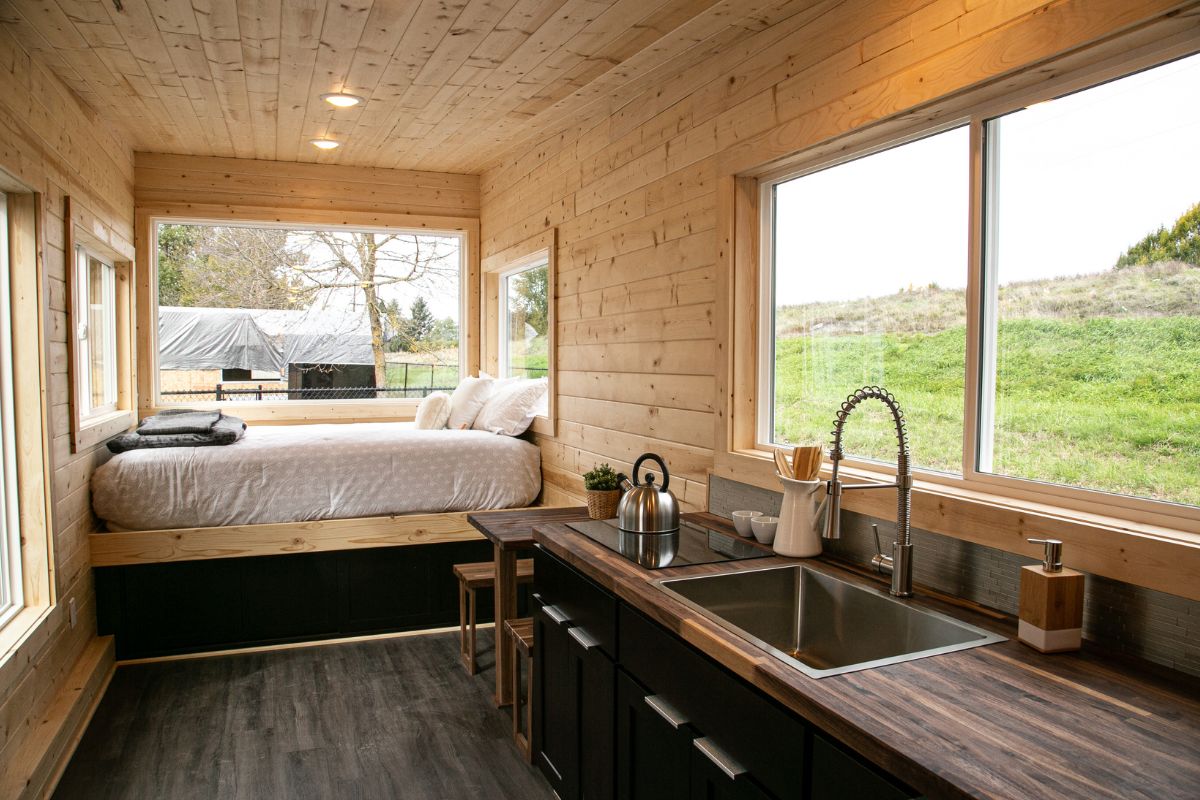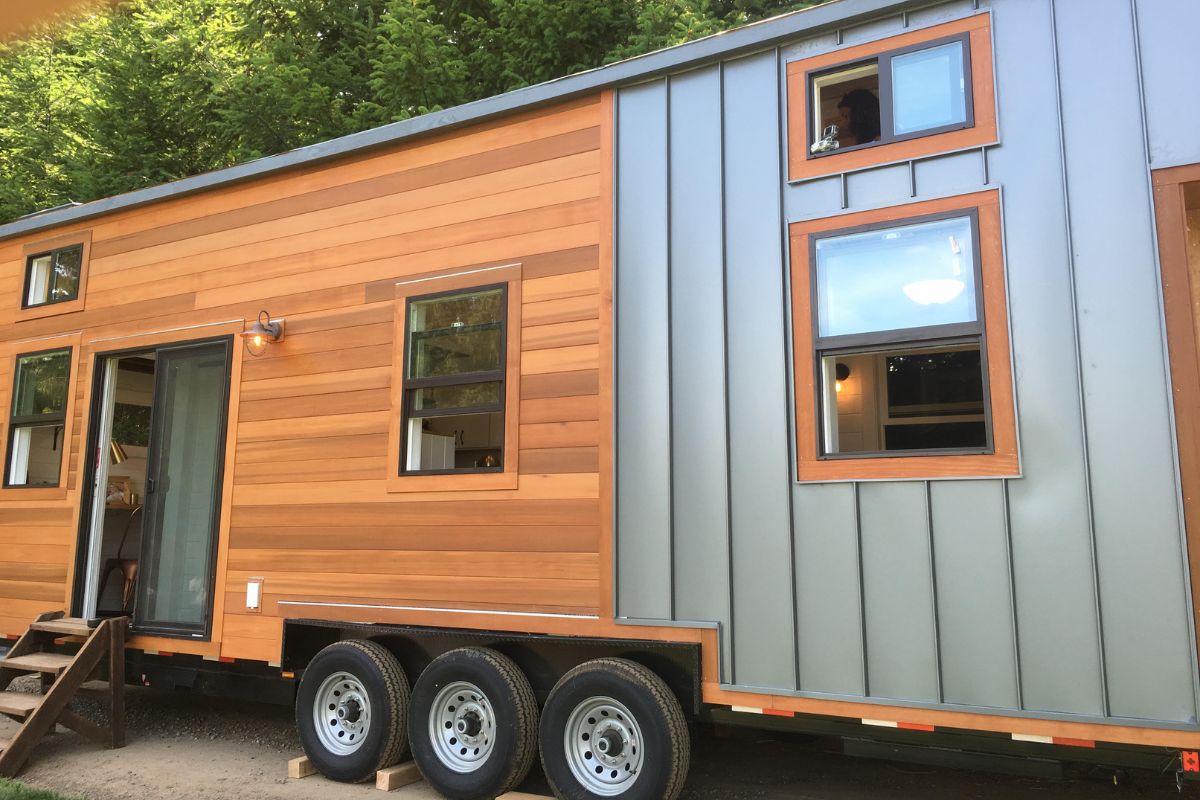Yet, it's not without its obstacles. Balancing everyone's needs in a limited space can be a tricky puzzle, and privacy becomes a premium commodity. Still unsure if this lifestyle is for you? Stay with us as we unpack the realities, both rewarding and challenging, of tiny house living with children.
Things to Consider
Before making the switch to tiny house living with kids, there are important factors you need to ponder. It's significant to think about the number of children who will be sharing the space, if there will be an infant needing special accommodations, and whether you or your kids require private areas.
These considerations are key in ensuring a smooth change and a comfortable living environment for everyone.
How many kids will be living in the tiny house?
When considering a shift to tiny house living, it's essential to think about the number of kids who will be sharing the compact space with you. Evaluating the size of your family will greatly influence your design plans and space utilization.
If you have one child, you might get by with loft bedrooms. But, with two or more kids, you'll need to think creatively about sleeping arrangements. Don't forget to factor in their ages and genders. As they grow, boys and girls may need their own spaces.
Consider also their hobbies and activities. The more kids you have, the more storage you'll need for clothes, toys, and other essentials. Remember, it's all about balancing your family's needs with the constraints of tiny living.
Will there be an infant in the tiny house?
If you're planning to bring an infant into your tiny house, there are several critical considerations to keep in mind to guarantee their safety and comfort. To start with, baby-proofing your tiny house is a must.
You'll need to secure any loose items, cover sharp corners, and install safety gates on stairs or lofts. Next, consider where your baby will sleep. Creating a cozy, safe corner for a crib is essential. Third, think about storage for baby items like diapers, clothes, and toys.
Innovative storage solutions will be your best friend. Lastly, consider the noise factor. Infants need quiet for their naps, so planning for sound insulation might be necessary.
Remember, with some thought and creativity, tiny house living with an infant can work beautifully.
Do you or your kids need private space?
Living with kids in a tiny house, you might wonder about the provision of private space – a factor that deserves careful thought and planning. While the cozy environment can bolster family bonding, everyone needs some downtime.
Your little ones might require a quiet corner for reading or playing, while teens could need a space to retreat with their thoughts.
It's vital to contemplate these needs while designing your tiny home. Innovative solutions like convertible furniture or lofted spaces can create semi-private areas. Encourage open communication about privacy needs and mutually respect these boundaries.
Remember, living in a tiny house doesn't mean sacrificing personal space. With creativity and understanding, you can carve out private nooks in your compact haven.
Advantages of Tiny House Living with Kids
Embracing tiny house living with your kids can present numerous unique advantages.
Picture a simpler lifestyle where your family learns to value experiences over possessions and financial freedom allows for more quality time spent together.
Not only does this lifestyle promote bonding, but it also instills environmental consciousness in your children from an early age.
Simple Lifestyle
When you choose to live in a tiny house with your family, you're not just opting for a smaller space, but also embracing a simplified lifestyle that can have profound benefits for your children.
This lifestyle promotes minimalism, allowing your kids to learn the importance of valuing possessions and practicing mindful consumption. They'll understand the joy of living with purpose and simplicity, sparking creativity and imagination.
They'll also learn to appreciate the little things, as space constraints naturally teach organization and appreciation for what is owned. This unique lifestyle not only simplifies daily routines but also instills lifelong values in your children.
It's an opportunity to cultivate gratitude, responsibility, and intentionality, shaping them into conscious and considerate individuals.
Financial Freedom
Financial freedom is another significant advantage that tiny house living offers to families with children. Think about it: smaller space equals smaller expenses. You'll notice significant savings in utilities, maintenance, property taxes, and mortgage payments.
These lower living costs can help you reduce debt and build a solid financial foundation. You may even find you have more money to invest in experiences, like family trips or learning opportunities, instead of material possessions. This financial stability can also reduce stress, allowing you to focus more on enjoying quality time with your children.
The lessons learned in prioritizing experiences over possessions and living within one's means are priceless, teaching your kids about fiscal responsibility from an early age.
Bonding
Living in a tiny house with your kids can greatly strengthen your family bonds, nurturing a sense of unity that larger homes may not necessarily provide. The close quarters encourage constant interaction, sparking conversations and shared experiences you might otherwise miss.
Imagine cooking together in a compact kitchen or figuring out a board game in a cozy living area. These shared activities can greatly improve your family ties, nurturing a deep, lasting connection.
In a tiny house, every moment becomes quality time, creating beautiful, indelible family memories. Plus, you'll also instill in your kids the value of togetherness.
So, while tiny house living might seem challenging, it's an opportunity to bond, making it a rewarding choice for your family.
Environmental Consciousness
Embracing tiny house living with your kids can lead to a deeper understanding and consciousness of the environment. By living small, you're demonstrating the importance of reducing waste and conserving resources. You're teaching your children that happiness doesn't lie in the abundance of possessions, but rather in the richness of experiences and relationships.
Living in a tiny house cultivates eco-friendly habits from an early age. You're showing your kids the impact of their actions on the environment. This lifestyle encourages recycling, energy efficiency, and mindful consumption. These practices not only benefit the planet but also instill in your kids a sense of responsibility and respect for nature.
Your decision to live tiny empowers your children to become nurturers of the environment, nurturing a sustainable future.
.jpg)
Disadvantages of Tiny House Living with Kids
While tiny house living with kids can bring families closer, it's not without its challenges. The lack of space can seem overwhelming, and finding room for everything in a limited area requires creativity.
Balancing privacy, personal boundaries, and the demands of multifunctional spaces also adds to the complexity of this lifestyle choice.
Lack of space
Solving the square footage puzzle of a tiny home can pose quite a challenge, especially when you're trying to accommodate the varying needs of your kids. Every toy, every piece of furniture, even the kids themselves, all need their own space.
Limited square footage means you'll constantly be finding new ways to utilize space efficiently.
With a lack of space, finding room for play, study, relaxation, and storage can be tough. You'll have to get creative with solutions for comfort, ensuring every inch is used effectively.
Balancing the needs of your children in such a compact environment may seem challenging, but remember, it's not impossible. It's all about smart design, organization, and a bit of flexibility.
Tiny house living requires a certain kind of ingenuity, but with careful planning, it can work for your family.
Boundaries
After tackling the space challenge, another aspect of tiny house living with kids that might require some clever navigation is maintaining privacy and personal boundaries.
When you're all sharing a compact environment, it's easy to feel like you're constantly on top of each other. This can be particularly stressful for older children who crave a little bit of independence and personal space.
Establishing boundaries is critical, but it's not always easy in such a confined space. Everyone needs a place to retreat to, a space that's solely their own. Finding moments of solitude can be a real challenge.
Communication and respect become essential tools in preserving each family member's privacy, ensuring everyone's needs are met. This can be a tricky balancing act, but with careful planning and understanding, it's feasible.
Multifunctional spaces
Living in a tiny house with kids means that every area must serve multiple purposes, presenting yet another challenge. Your dining table might double as a workspace for your crafts, or your children's play area.
It's a constant juggling act, trying to maintain order while ensuring everyone's needs are met.
This multitasking of spaces can lead to a lack of a defined structure or organization in your home. One minute, you're eating dinner, the next, you're clearing the table to set up a board game.
Your kids might struggle with focusing on homework when their desk is also their toy storage. You'll find yourself constantly rearranging, which can be exhausting.
Despite the creative solutions you'll certainly devise, the constant shifting can be a significant drawback to tiny house living with kids.
Storage Constraints
While juggling multifunctional spaces is a challenge in itself, dealing with limited storage in a tiny house is another hurdle you'll face when living with kids. Remember, in a limited space, every inch counts.
You'll need to be creative with storage solutions, using every nook and cranny to store toys, clothes, and other essentials.
This could mean investing in furniture that doubles as storage or using vertical space effectively. It'll also mean regular decluttering — teaching your kids to value and care for their belongings, and to let go of items they no longer need.
While this could be a struggle, it's also a valuable lesson in minimalism and mindful consumption. So, although challenging, storage constraints can also be an opportunity for growth and learning.
Tips for Tiny House Living with Kids
Living in a tiny house with kids can be both rewarding and challenging. It's important to establish routines, optimize your space, and engage your children in the design process.
By also embracing outdoor living, you're setting your family up for a successful tiny house living experience.
Establish Routines
In the confined space of a tiny house, establishing consistent routines can greatly improve your family's overall living experience.
With limited room to move, it's essential to maintain order. Start by defining specific areas for different activities, like eating, playing, or studying. This will help your kids understand where to do what, minimizing chaos.
Implement a regular cleaning routine and involve your children. It'll teach them responsibility and the importance of cleanliness.
Have designated spaces for their belongings and encourage them to keep their things organized. This avoids clutter and promotes respect for the shared space.
Lastly, create a schedule that accommodates everyone's needs.
Consistent meal times, study hours, and bedtimes create a sense of predictability and comfort. Remember, routine is key to harmonious tiny house living with kids.
Optimize Space
Moving from routines to managing space, let's explore some tips to make the most out of every square foot in your tiny home. Start by using vertical space creatively. Install shelves or racks on walls to store books, toys, and other essentials.
Consider furniture that serves dual purposes like a bed with built-in drawers or a table that folds into a wall. Don't forget the potential of under-utilized spaces such as under beds or sofas.
Opt for foldable or collapsible items that can be stored away when not in use.
Finally, involve your kids in organizing their stuff. Teach them the importance of keeping their belongings in designated places. It's all about smart, creative, and efficient use of space.
Outdoor Living
Embracing the great outdoors can greatly improve your lifestyle and provide much-needed extra space for tiny house living with kids.
Make the outdoors an extension of your home. Create an outdoor living area with comfortable seating, a fire pit, and even an outdoor kitchen. This not only gives you more space but also encourages your kids to engage with nature.
Use your yard as a playground. Install swings, slides, or a sandpit to keep them entertained. Remember, the outdoors can also be an educational space. Start a garden, and teach your kids about plants and how they grow.
Through this, they'll learn responsibility and the value of hard work. Outdoor living can significantly boost your tiny house living experience with kids.
Engage With the Kids During the Design Process
Getting your kids involved in the design process of your tiny home can be an enriching and fun experience for everyone. It's a chance to teach them about space utilization, creativity, and the importance of making a place their own.
Start by including them in the brainstorming phase, let them share their ideas and preferences. They could help in choosing colors, materials, or even the layout of their own rooms.
This makes them feel valued and heightens their confidence.
Plus, customizing their space to their needs and interests guarantees they'll love and respect it. It's a win-win situation: your kids get a practical lesson in design and planning, and you end up with a home that truly serves your family's needs and desires.
Tiny House Plans for 4 to 6 People
When planning for a tiny house that fits a family of 4 to 6, consider the Trove and Polaris tiny house plans. These well-thought-out designs offer practical solutions for space optimization, ensuring comfort and functionality.
Let's explore the features that make these plans ideal for your tiny living with kids.
The Trove Tiny House Plan
If you're planning for a family of 4 to 6 people, the Trove Tiny House Plan offers a practical and beautifully designed solution to make the most out of your compact living space. This plan is not just about fitting everyone in, but creating a comfortable and functional home that everyone loves.
It features an open floor plan that maximizes space, while still providing enough privacy for each family member. The kitchen is designed for efficiency, with ample storage and prep space.
There are also clever storage solutions throughout, ensuring that everything has its place. The sleeping areas are designed to be cozy and private, promoting restful sleep. The Trove Tiny House Plan proves that living small doesn't mean compromising on comfort, functionality, or style.
Polaris Tiny House Plan
Just as the Trove Tiny House Plan serves families of 4 to 6, the Polaris Tiny House Plan offers another fantastic option for those seeking to adopt the tiny house lifestyle with a larger family.
This plan, specifically designed for families, boasts of an open layout that promotes communal living while also providing private spaces. It features a main floor bedroom and the option for two additional lofted spaces, providing enough room for each family member.
The functional kitchen and living areas facilitate family bonding. The Polaris Plan also includes detailed construction drawings for easy building.
Remember, it's your duty to make sure the plan meets local building codes. Embrace the tiny house lifestyle with the Polaris Tiny House Plan, a perfect blend of comfort, functionality, and smart design.
Conclusion
So, embracing tiny house living with kids can be both rewarding and challenging. When planned well, it encourages bonding, simplicity, and eco-consciousness. Yes, space and privacy might be issues, but with creativity and flexibility, you can overcome these hurdles.
By considering everyone's needs, you can create a nurturing, comfortable home. Remember, in tiny house living, it's about making the most of less. So, are you ready to start on this unique, less-is-more journey with your family?






Share: